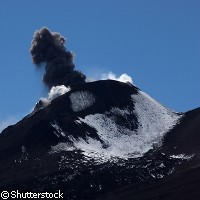Scientists simulate volcanic signals in lab for first time
The seismic signals that often precede a volcanic eruption have been recreated in the lab for the first time by a team of EU-funded scientists. The work, which was partly funded by a Marie Curie outgoing international research fellowship from the Sixth Framework Programme (FP6), is published in the latest edition of the journal Science. The researchers violently deformed blocks of basalt rock taken from Mount Etna, which is located on the southern Italian island of Sicily. The seismic signals generated during this process were monitored with an array of highly sensitive instruments. The instruments detected low-frequency events that the scientists liken to the sound made by a church organ pipe and which are found in volcanic regions around the world. In a volcano, these sounds are generated when water, steam, gas or magma rushes through tiny cracks and fractures in the rock. Crucially, the scientists discovered that their laboratory findings could be accurately scaled up to natural volcanoes, with 50-millimetre cracks in the lab behaving like 200-metre cracks in nature. The researchers hope that this new-found ability to recreate volcanic conditions in the lab will eventually make it easier to predict when and how a volcano will erupt. Some 500 million people live near enough to an active volcano to suffer significant physical or economic harm should a serious eruption take place. Around 10% of the EU's population is thought to be economically vulnerable to volcanic eruptions. In addition to seismic signals, scientists draw on ground deformation analyses and geochemical data (for example from escaping gases) to predict when a volcano might erupt. 'The holy grail of volcano research is to be able to predict with complete accuracy when and how exactly a volcano will erupt,' explained Philip Benson, Marie-Curie Research Fellow at University College London, UK, who carried out the experiments at a special facility for studying rock fracture dynamics at the University of Toronto in Canada. 'We are not there yet and, frankly, we may never be able to achieve that level of detail. However, being able to simulate the pressure conditions and events in volcanoes greatly assists geophysicists in exploring the scientific basis for volcanic unrest, ultimately helping cities and towns near volcanoes know whether to evacuate or not.' The findings could also have applications in other fields concerned with rock fractures, including mining, construction, oil and gas exploration and earthquake research. Paul Young, the University of Toronto's vice president, was also involved in the research. He welcomed the fact that Dr Benson had used his Marie Curie grant to carry out research in Toronto. 'Philip could have gone anywhere in the world with this prestigious Marie Curie Fellowship and he chose the University of Toronto,' he commented. Professor Young added, 'The investment by the Canada Foundation for Innovation enabled the design and construction of a state-of-the-art experimental fracture facility that has led to globally competitive research innovation and a strengthening of our ability to attract the best talent to Canada. This is also a perfect example of how government support of research has huge societal benefits.'



